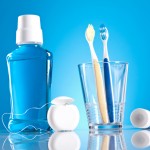
There is good evidence that toothbrushing reduces gingivitis and that tooth brushing with fluoride toothpaste reduces tooth decay. The aim of this study was to compare the antimicrobial effects of three commercially available toothpastes.
Thirty-five adults (15 men and 20 women; average age 33 years and pockets <5 mm with a minimum of 20 natural teeth participated in this double-blind, triple-crossover study. The toothpastes tested were:-
- sodium fluoride/triclosan/copolymer dentifrice (TCN/C) (Colgate® Total®; Colgate-Palmolive Company, New York, NY,USA),
- stannous fluoride/sodiumhexametaphosphate/zinc lactate dentifrice(SnF2/SHMP, Crest® Pro-Health®; Procter & Gamble Company,Cincinnati, OH, USA)
- sodium fluoride dentifrice (NaF, Crest® Cavity Protection; Regular Paste, Procter & Gamble Company
A specific toothpaste was randomly assigned for twice-daily use for 13 days with microbial samples being collected on day 14, 12 h after brushing, alternate dentifrices followed this identical protocol with a 1-month washout period. Baseline samples from four sites, plaque, saliva, tongue and buccal mucosa, were collected and evaluated for six microbial types, anaerobes, Streptococci, Actinomyces, hydrogen-sulphide (H2S)-producing bacteria, Fusobacteria andVeillonella.
They found that:-
For all four oral sites and six organisms evaluated in each site, the TCN/C demonstrated significant reductions (49–83%) as compared with the other treatments (p < 0.01). The SnF2/SHMP group showed significant reductions of 14–43% for 14 of 24 outcomes as compared with the NaF group (p < 0.01), with no differences in 10 outcomes.
The authors concluded
The TCN/C dentifrice formulation consistently demonstrated significant reductions for a range of microorganisms in diverse oral sites in comparison with the NaF, or the SnF2/SHMP dentifrice formulations as seen 12 h after brushing
Study funding:– This study was supported by a grant from the Colgate-Palmolive Company and Dr. Sreenivasan is an employee of the company.
Comment
Brushing with toothpaste is an regular habit for large proportions of the population, and using toothpaste as a vehicle to deliver agents to help improve oral health has had an important impact on dental caries as a result of the incorporation of fluoride. As toothbrushing removes dental plaque a primary cause of gingivitis the addition of antimicrobials to reduce the bacterial load in plaque and in the mouth that are associated with gingivitis, periodontal disease and halitosis seems to be a sensible approach to oral health improvement.
This study is interesting as it does show that the TCN/C paste produced larger reduction than the other two pastes. However, this is a short term study and although statistically significant these reductions may not be clinically significant in the short or long term. The study has also been conducted on patients with good oral health so the impact on those with poorer oral health may be different.
Three reviews of the use of antimicrobials in toothpaste have been published previously ( Gunsolley 2006, Hioe 2005, Davies 2004) and although these reviews tend to suggest small benefits for some of these agents many of the included studies are again small and of relatively short duration.
Links
Fine DH,Sreenivasan PK, McKiernan M, Tischio-Bereski D, Furgang D. Whole mouth antimicrobial effects after oral hygiene: comparison of three dentifrice formulations. J Clin Periodontol. 2012 Aug 11. doi:10.1111/j.1600-051X.2012.01938.x. [Epub ahead of print] PubMed PMID: 22924756.
Gunsolley JC. A meta-analysis of six-month studies of antiplaque and antigingivitis agents. J Am Dent Assoc. 2006 Dec;137(12):1649-57. Review. PubMed PMID: 17138709.
Hioe KP, van der Weijden GA. The effectiveness of self-performed mechanicalplaque control with triclosan containing dentifrices. Int J Dent Hyg. 2005 Nov;3(4):192-204. Review. PubMed PMID: 16451308.
Davies RM, Ellwood RP, Davies GM. The effectiveness of a toothpaste containing triclosan and polyvinyl-methyl ether maleic acid copolymer in improving plaque control and gingival health: a systematic review. J Clin Periodontol. 2004 Dec;31(12):1029-33. Review. PubMed PMID: 15560802.
